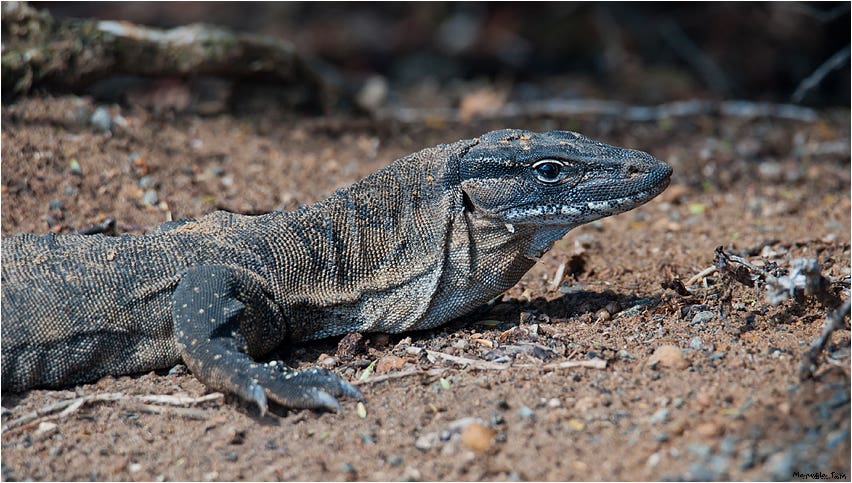Australia’s giant lizards help safeguard sheep from being eaten alive
Giant lizards known as heath goannas have the potential to save Australian sheep farmers millions of dollars annually

Giant lizards known as heath goannas have the potential to save Australian sheep farmers millions of dollars annually by controlling blowfly populations, according to researchers who emphasize the importance of prioritizing these lizards in conservation efforts to enhance native wildlife.
A study led by the University of Cambridge reveals that heath goannas, which are large, scavenging lizards, act as natural clean-up crews by removing maggot-infested animal carcasses from the environment.
This behavior significantly reduces the presence of blowflies, insects notorious for laying eggs on sheep, leading to a condition called "fly strike." Fly strike, which results in flesh-eating maggots burrowing into the sheep's skin, costs the Australian sheep farming industry an estimated $280 million each year.
The study was conducted across 18 sites within the Marna Banggara Rewilding Project area on Australia's southern Yorke Peninsula, a region where over 90% of native mammals have gone extinct. The findings highlight that heath goannas provide superior blowfly control compared to introduced European mammals such as red foxes and cats, which are currently displacing the native reptiles.
Researchers argue that increasing the population of large native reptiles like heath goannas is crucial for restoring Australia’s ecosystems and the various services they provide.
“We found that Australia’s native scavengers like heath goannas are much more effective in removing blowflies from the landscape than invasive scavengers like European foxes and cats,” said Tom Jameson, a PhD researcher in the University of Cambridge’s Department of Zoology and lead author of the study.
Related Stories
High blowfly densities pose a severe threat to sheep, causing fly strike, a condition where maggots burrow into the sheep’s flesh, resulting in painful wounds that decrease the market value of the sheep, hinder breeding success, and often lead to death.
“Blowflies are a massive problem for the Australian sheep farming industry. They cause a horrible disease that is expensive for farmers to manage and a real animal welfare problem for sheep,” added Jameson.
Published in the journal Ecology and Evolution, this is the first study to demonstrate the critical role of large reptiles as scavengers. To obtain these results, Jameson compared the scavenging activities of different animals in a southern Australian region by placing hundreds of dead rats at feeding stations equipped with camera traps.
After five days, he assessed whether the rats had been consumed and counted the blowfly maggots on any remaining carcasses. Camera footage revealed which scavenger found the rat and how quickly it was eaten.
Native Australian scavengers consumed more dead rats and the associated flesh-eating maggots than their European counterparts. “It was disgusting – we were counting maggots. After five days we’d find over 1000 maggots in one rat if a scavenger hadn’t found it. Those maggots produce blowflies that can spread up to 20 kilometers in a week, putting local sheep flocks at risk of fly strike,” said Jameson.
In natural settings, any dead animal in the landscape quickly becomes infested with blowfly maggots. “The results suggest that conservation work in southern Australia to remove invasive species should also focus on boosting the population of heath goannas and other native species because they’re really important for the wider ecosystem,” Jameson noted. He further emphasized that bolstering native wildlife populations would benefit the local agricultural industry and promote wildlife tourism.
The Marna Banggara project, supported by Narungga traditional owners, is a rewilding initiative aimed at restoring ecosystem health in the region by reintroducing native Australian species that have disappeared.
European settlers in the 18th century brought red foxes for hunting and cats as pets to Australia, leading to the decimation of native wildlife, including many scavengers. The heath goanna, an endangered giant lizard native to the heathlands of southern Australia, can grow up to one and a half meters in length and feeds on both dead and live animals. Today, reptiles like the heath goanna are among the largest remaining native land scavengers in much of Australia.
By prioritizing the conservation of these large native reptiles, Australia can restore its ecosystems, support native wildlife, and bolster local economies through improved agriculture and increased wildlife tourism.
For more science news stories check out our New Discoveries section at The Brighter Side of News.
Note: Materials provided above by The Brighter Side of News. Content may be edited for style and length.
Like these kind of feel good stories? Get the Brighter Side of News' newsletter.
Joshua Shavit
Science & Technology Writer | AI and Robotics Reporter
Joshua Shavit is a Los Angeles-based science and technology writer with a passion for exploring the breakthroughs shaping the future. As a contributor to The Brighter Side of News, he focuses on positive and transformative advancements in AI, technology, physics, engineering, robotics and space science. Joshua is currently working towards a Bachelor of Science in Business Administration at the University of California, Berkeley. He combines his academic background with a talent for storytelling, making complex scientific discoveries engaging and accessible. His work highlights the innovators behind the ideas, bringing readers closer to the people driving progress.



